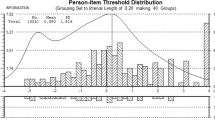Abstract
The current study examined the impact of financial costs and self-reported economic pressure on the quality of life of patients with progressive neurological illness. Participants were 423 people from four illness groups in Australia. Participants completed measures of (a) quality of life, (b) income, (c) expenses, (d) economic pressure, (e) social support, (f) relationship satisfaction, and (g) severity of illness. There was a strong negative association between quality of life and economic pressure (but not income or expenses) for all groups. Subjective assessment of economic pressure was strongly associated with quality of life for people with motor neurone disease and multiple sclerosis. Implications of these results for assisting people with progressive neurological illnesses to cope with the financial changes that occur due to their illness are discussed.
Similar content being viewed by others
References
Boyce, P., & Hickey, A. (2005). Psychosocial risk factors to major depression after childbirth. Social Psychiatry and Psychiatric Epidemiology, 40, 605–612.
Brown, M., Lipscomb, J., & Snyder, C. (2001). The burden of illness of cancer: Economic cost and quality of life. Annual Review of Public Health, 22, 91.
Calhoun, E. A., McNaughton, C. M., Pontari, M. A., O’Leary, M., Leiby, B. E., Landis, R. J., et al. (2004). The economic impact of chronic prostatitis. Archives of Internal Medicine, 164, 1231–1236.
Conger, R. D., Conger, K. J., Elder, G. H., Lorenz, F. O., Simons, R. L., & Whitbeck, L. B. (1992). A family process model of economic hardship and adjustment of early adolescent boys. Child Development, 63, 526–541.
Cummins, R. A. (2000). Personal income and subjective well-being: A review. Journal of Happiness Studies, 1, 133–158.
De Judicibus, M. A., & McCabe, M. P. (2007). The impact of the financial costs of multiple sclerosis on quality of life. International Journal of Behavioral Medicine, 14, 3–11.
Elizur, Y., & Hirsh, E. (1999). Psychosocial adjustment and mental health two months after coronary artery bypass surgery: A multisystemic analysis of patients’ resources. Journal of Behavioral Medicine, 22(2), 157–177.
Goldsmith, C. (2001). Neurological disorders. The amazing brain. Woodbridge, CT: Blackbirch Press.
Gudmunson, C. G., Beutler, I. F., Israelsen, C. L., McCoy, J. K., & Hill, E. J. (2007). Linking financial strain to marital instability: Examining the roles of emotional distress and marital interaction. Journal of Family and Economic Issues, 28, 357–376.
Hendrick, S. S. (1988). A generic measure of relationship satisfaction. Journal of Marriage and the Family, 50, 93–98.
Hendrick, S. S., Dicke, A., & Hendrick, C. (1998). The relationship assessment scale. Journal of Social and Personal Relationships, 15, 137–142.
Jonsson, B. (1998). The economic impact of diabetes. Diabetes Care, 21, 7–10.
Lai, D. W. L., & Leonenko, W. (2007). Effects of caregiving on employment and economic costs of Chinese family caregivers in Canada. Journal of Family and Economic Issues, 28, 411–427.
Lavee, Y. (2005). Correlates of change in marital relationships under stress: The case of childhood cancer. Families in Society, 86, 112–120.
McCabe, M. P., Roberts, C., & Firth, L. (2008). Work and recreational changes among people with neurological illness and their caregivers. Disability and Rehabilitation, 30, 600–610.
McCabe, M. P., Firth, L., & O’Connor, E. J. (2009a). Mood, quality of life, symptoms, and length of illness: Impact of neurological illness. International Journal of Clinical & Health Psychology, 9, 21–35.
McCabe, M. P., Firth, L., & O’Connor, E. J. (2009b). Comparison of mood and quality of life among people with progressive neurological illnesses and their caregivers. Journal of Clinical Psychology in Medical Settings, 16, 355–362.
Mimura, Y. (2008). Housing cost burden, poverty status, and economic hardship among low-income families. Journal of Family and Economic Issues, 29, 152–165.
O’Connor, E. J., & McCabe, M. P. (2008). The impact of neurological illness on marital relationships. Journal of Sex and Marital Therapy, 34, 115–132.
O’Hara, B. (2004). Do mothers work to support ailing husbands? Journal of Family and Economic Issues, 25, 179–198.
Parks-Yancy, R., DiTomaso, N., & Post, C. (2007). The mitigating effects of social and financial capital resources on hardships. Journal of Family and Economic Issues, 29, 429–448.
Quarrell, O. (2004). Huntington’s disease: The facts. New York: Oxford University Press.
Rettig, K. D., Leichtentritt, R. D., & Danes, S. M. (1999). The effects of resources, decision making, and decision implementing on perceived family well-being in adjusting to an economic stressor. Journal of Family and Economic Issues, 20, 5–34.
Rohrbaugh, M. J., Shoham, V., & Coyne, J. C. (2006). Effect of marital quality on eight-year survival of patients with heart failure. American Journal of Cardiology, 98, 1069–1072.
Sarason, I. G., Levine, H. M., Basham, R. B., & Sarason, B. R. (1983). Assessing social support: The social support questionnaire. Journal of Personality and Social Psychology, 44, 127–139.
Sarason, I. G., Sarason, B. R., Shearin, E. N., & Pierce, G. R. (1987). A brief measure of social support: Practical and theoretical implications. Journal of Social and Personal Relationships, 4, 497–510.
Tamparo, C. D., & Lewis, M. A. (2005). Diseases of the human body (4th ed.). Philadelphia: Davis.
Waldron, N. (2006). Funding decisions in chronically sick individuals. British Journal of Nursing, 15, 286–291.
White-Means, S. I., & Rubin, R. M. (2004). Trade-offs between formal home health care and informal family caregiving. Journal of Family and Economic Issues, 25, 335–358.
WHOQOL Group Development of the World Health Organization. (1998). WHOQOL-BREF quality of life assessment. Psychological Medicine, 28, 551–558.
Zabalegui, A., Sanchez, S., Sanchez, P. D., & Juando, C. (2005). Nursing and cancer support groups. Journal of Advanced Nursing, 51, 369–381.
Acknowledgements
The authors would like to thank the Motor Neurone Disease Association of Victoria, Australian Huntington’s Disease Association of Victoria, Multiple Sclerosis Australia and Parkinson’s Victoria for their support in this research.
Author information
Authors and Affiliations
Corresponding author
Rights and permissions
About this article
Cite this article
McCabe, M.P., O’Connor, E.J. The Economic Impact of Progressive Neurological Illness on Quality of Life in Australia. J Fam Econ Iss 31, 82–89 (2010). https://doi.org/10.1007/s10834-009-9177-4
Published:
Issue Date:
DOI: https://doi.org/10.1007/s10834-009-9177-4




